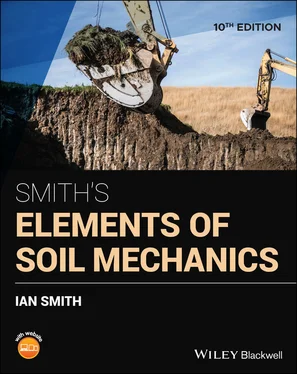4 Chapter 7Table 7.1 Guidance values for spacing and pattern of investigation points.Table 7.2 Maximum spacing, X maxand minimum number, N minof ground investigat...Table 7.3 Guidance values for minimum depth (z a) of investigation points.Table 7.4 Guidance values for minimum depths of investigation points.Table 7.5 Quality classes of soil samples for laboratory testing and sampling...Table 7.6 Sampling by drilling – sampling categories for different soil types...Table 7.7 Sampling using samplers – sampling categories for different soil ty...Table 7.8 Correction factors for overburden effective vertical stress,  (kPa)...Table 7.9 Correction factors for rod length in sands.Table 7.10 Correlation between Normalised blow count (N 1) 60and density index...Table 7.11 Estimates of ϕ' from I Dand C u.
(kPa)...Table 7.9 Correction factors for rod length in sands.Table 7.10 Correlation between Normalised blow count (N 1) 60and density index...Table 7.11 Estimates of ϕ' from I Dand C u.
5 Chapter 8Table 8.1 Values of K aand K acfor a cohesive soil for β = 0, ψ = 9...Table 8.2 Values of K pfor cohesionless soils.Table 8.3 Values of K pand K pcfor a cohesive soil for β = 0; ψ = 9...Table 8.4 Values of K pand K pc.
6 Chapter 9Table 9.1 Partial factors for the verification of ground resistance for persi...Table 9.2 Acceptable F pvalues for ranges of ϕ′ .Table 9.3 Values of γ G; favand γ Refor each design approach.Table 9.4 Values of γ G; fav, γ G; unfav, and γ Refor each design...Table 9.5 Partial factors for the verification of passive resistance against ...
7 Chapter 10Table 10.1 Bearing capacity factors in common use.Table 10.2 Presumed safe bearing capacity, q s, values.
8 Chapter 11Table 11.1 Typical values for δ and K s.Table 11.2A Correlation factors – static load tests results (from EN 1997‐1:2...Table 11.2B Correlation factors – static load tests results (from NA to BS EN...Table 11.3A Piles in compression: partial factor sets R1, R2, R3, and R4 (fro...Table 11.3B Piles in compression: partial factor sets R1, R2, R3, and R4 (fro...Table 11.4A Correlation factors – ground tests results (from EN 1997‐1:2004 T...Table 11.4B Correlation factors – ground tests results (from NA to BS EN 1997...Table 11.5A Model factor values for the verification of R cdby calculation (C...Table 11.5B Model factor values for the verification of R cdby calculation (C...Table 11.6 Correlation factors for pile design by calculation (Method B).Table 11.7 Correlation factors for pile design based on results of static loa...Table 11.8 Partial factors for the verification of ultimate compressive axial...Table 11.9 Partial factors for the verification of ultimate compressive axial...
9 Chapter 12Table 12.1 Values of Terzaghi's N p.Table 12.2 Values of Skempton's I p.Table 12.3 m vranges for different soil types.Table 12.4 Values of α .
10 Chapter 15Table 15.1 Equilibrium CBR values for common soils in UK.
1 Chapter 1 Fig. 1.1 Materials encountered during excavation. Fig. 1.2 The rock cycle. Fig. 1.3 Example 1.2. Fig. 1.4 Pipette analysis arrangement. Fig. 1.5 Changes in volume against water content. Fig. 1.6 Fall cone apparatus. Fig. 1.7 Example 1.4. Fig. 1.8 Relationship between I Pand clay percentage. Fig. 1.9 (a) Plasticity chart based on BS 5030 (BSI, 2015) (b) Plasticity ch... Fig. 1.10 Example 1.6. Fig. 1.11 Cross‐section through a granular soil. (a) Actual form. (b) Ideali... Fig. 1.12 Water and air contents in a soil. (a) Dry soil. (b) Saturated soil... Fig. 1.13 Pycnometer used in the determination of particle density. (a) Pycn...
2 Chapter 2 Fig. 2.1 Tendency of the water table to follow the earth's surface. Fig. 2.2 Types of subsurface water. Fig. 2.3 Difference in hydraulic head between two points. Fig. 2.4 The constant head permeameter. Fig. 2.5 The falling head permeameter. Fig. 2.6 Field pumping test. Fig. 2.7 Element in an orthotropic soil. Fig. 2.8 Flow net for seepage beneath a dam. Fig. 2.9 Section of a flow net. Fig. 2.10 Example of flow net construction. (a) Problem. (b) Boundary condit... Fig. 2.11 Upward flow through a soil sample. Fig. 2.12 Examples where piping can occur. (a) Cofferdam. (b) Downstream end... Fig. 2.13 Example 2.6. Fig. 2.14 Example 2.7 Fig. 2.15 Capillary effects. Fig. 2.16 Example wetting and drying water retention curves. Fig. 2.17 Soil suction measurement – an arrangement for the filter paper met... Fig. 2.18 Part of a flow net for an earth dam. Fig. 2.19 Conditions at the start of an upper flow line. Fig. 2.20 Conditions at the downstream end of an upper flow line. (a) Flow l... Fig. 2.21 Types of seepage through an earth dam. (a) Impermeable base. (b) B... Fig. 2.22 Flow net for a theoretical earth dam. Fig. 2.23 The parabola. Fig. 2.24 Determination of upper flow line. Fig. 2.25 Dam resting on an impermeable soil. (a) Construction for upper flo... Fig. 2.26 Transformed and natural ‘squares’. (a) Transformed. (b) Natural. Fig. 2.27 Example 2.8. (a) The problem. (b) Flow net. Fig. 2.28 Example 2.9. Fig. 2.29 Example 2.10. Fig. 2.30 Example 2.11. Fig. 2.31 Effect of variation of permeability on a flow net. (a) k 2> k 1. (b... Fig. 2.32 Flow across an interface when the flow lines are at an angle to it... Fig. 2.33 Flow net for seepage through two soils of different permeabilities... Fig. 2.34 Exercise 2.4.
3 Chapter 3Fig. 3.1 Stress–strain relationships.Fig. 3.2 Three‐ and two‐dimensional stress states. (a) 3‐D stress system. (b...Fig. 3.3 Strains in the vertical and horizontal directions: isotropic linear...Fig. 3.4 Shear stress and strain.Fig. 3.5 Total stress in a homogeneous soil mass.Fig. 3.6 Hydrostatic pore water pressure.Fig. 3.7 Load carried by soil particles and pore water.Fig. 3.8 Example 3.1.Fig. 3.9 Example 3.2.Fig. 3.10 Example 3.3.Fig. 3.11 Example 3.4.Fig. 3.12 Example 3.5.Fig. 3.13 Influence coefficients for vertical stress from a concentrated loa...Fig. 3.14 Influence factors for the vertical stress beneath the corner of a ...Fig. 3.15 Example 3.7.Fig. 3.16 Bulbs of pressure for vertical stress. (a) Circular footing. (b) S...Fig. 3.17 Plate loading test may give misleading results.Fig. 3.18 Overlapping of pressure bulbs.Fig. 3.19 Pressure bulbs of shear stress. (a) Circular footing. (b) Strip fo...Fig. 3.20 Contact pressure distribution under a rigid foundation loaded with...Fig. 3.21 Exercise 3.2.Fig. 3.22 Exercise 3.3. (a) The problem. (b) Selection of rectangles.
4 Chapter 4Fig. 4.1 Friction on horizontal plane.Fig. 4.2 Shear stress – normal stress relationship.Fig. 4.3 Failure surface in a soil mass.Fig. 4.4 Complex stress.Fig. 4.5 Stress induced by two principal stresses, σ 1and σ 3, on a...Fig. 4.6 Mohr’s circle.Fig. 4.7 Example 4.1.Fig. 4.8 Mohr circle diagram for limit shear resistance.Fig. 4.9 Example 4.2.Fig. 4.10 Mohr strength envelope.Fig. 4.11 Relationship between ϕ and θ .Fig. 4.12 A cohesive soil subjected to undrained conditions and zero total n...Fig. 4.13 Mohr circle diagram.Fig. 4.14 Shear box assembly.Fig. 4.15 Shear box: shear stress against displacement.Fig. 4.16 Shear box: shear stress against normal stress.Fig. 4.17 Example 4.3.Fig. 4.18 Example 4.4.Fig. 4.19 Shear box results on loose and dense samples of the same soil: (a)...Fig. 4.20 The triaxial apparatus.Fig. 4.21 Stresses in the triaxial test.Fig. 4.22 Typical triaxial test results.Fig. 4.23 Types of failure in the triaxial test.Fig. 4.24 Mohr circles for saturated clay.Fig. 4.25 Example 4.4.Fig. 4.26 Example 4.5.Fig. 4.27 Example 4.7.Fig. 4.28 Example 4.8.Fig. 4.29 Mohr circles for undrained and drained tests at same cell pressure...Fig. 4.30 Mohr circle diagram for triaxial compression and tension tests.Fig. 4.31 The unconfined compression test.Fig. 4.32 The unconfined compression test Mohr circle.Fig. 4.33 Compressive principal stresses.Fig. 4.34 Effects of overconsolidation on the pore pressure coefficient A.Fig. 4.35 Example 4.9.Fig. 4.36 Example 4.10.Fig. 4.37 Strength envelope for a saturated cohesive soil subjected to an un...Fig. 4.38 Strength envelope for a normally consolidated clay subjected to a ...Fig. 4.39 Strength envelope for an overconsolidated soil subjected to a drai...Fig. 4.40 Typical results from consolidated undrained shear tests on saturat...Fig. 4.41 Relationship between N and ϕ′ .Fig. 4.42 The peak, critical, and residual strengths of clays.Fig. 4.43 Ring shear test sample.Fig. 4.44 Stress–displacement characteristics of sands.
Читать дальше

 (kPa)...Table 7.9 Correction factors for rod length in sands.Table 7.10 Correlation between Normalised blow count (N 1) 60and density index...Table 7.11 Estimates of ϕ' from I Dand C u.
(kPa)...Table 7.9 Correction factors for rod length in sands.Table 7.10 Correlation between Normalised blow count (N 1) 60and density index...Table 7.11 Estimates of ϕ' from I Dand C u.










